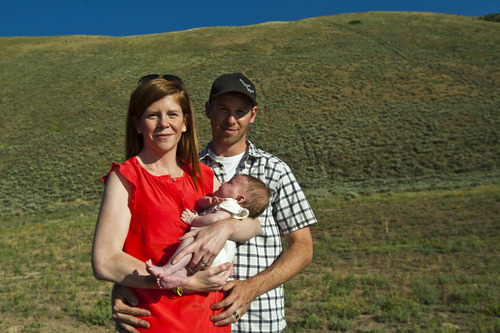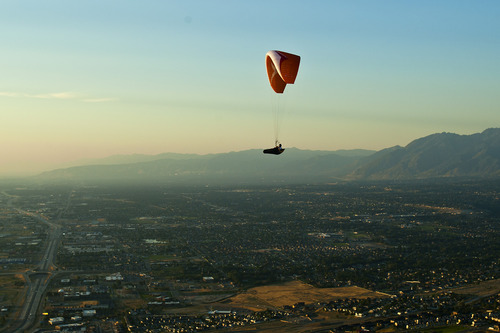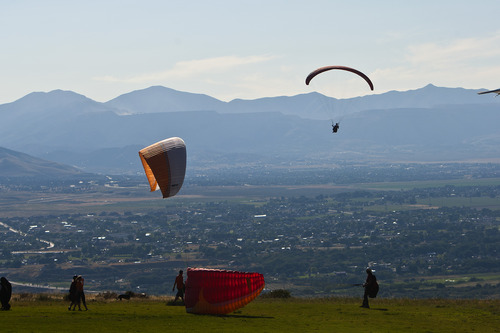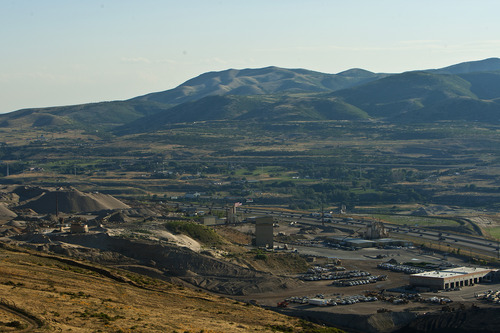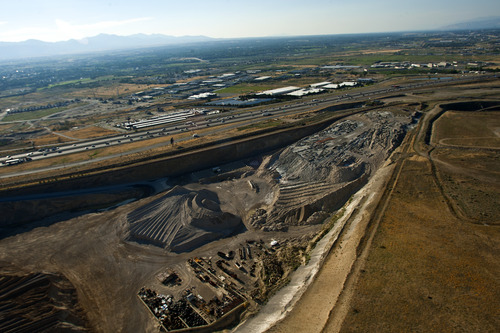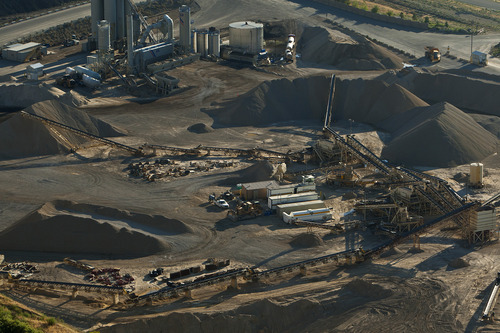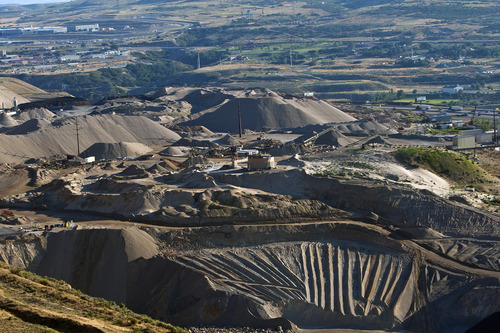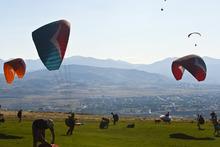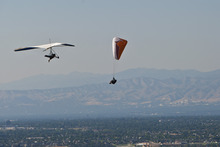This is an archived article that was published on sltrib.com in 2013, and information in the article may be outdated. It is provided only for personal research purposes and may not be reprinted.
Drifting in midair over Point of the Mountain, you can see what's causing the dust-up here.
Next to the interstate, trucks the size of small houses look like industrious ants crawling around Geneva Rock's sand and gravel pit below. At the neighboring flight park, pilots swarm the sky in paragliders and hang-gliders that fill the air with the festive colors of a child's birthday-party balloons.
And a film of dust blurs the vistas as far as you can see. The chalky haze obscures the Great Salt Lake to the north, the mountain ranges along the east and west and Utah Lake to the south.
Here at Point of the Mountain, the drive to develop is bumping up against the impulse to preserve. And, while discussions continue in search of mutually agreeable solutions, new concerns ballooned this spring as Geneva began digging deeper into the mountainside. Some have already given the iconic place a new nickname: Nub of the Mountain.
Martin Jensen, associate director of community services for Salt Lake County, says the county wants to find the best possible solution for everyone involved.
"All the right people are at the table," he said. "We're having the right discussions. We're moving in the right direction."
Among those driving the talks are Ryan and Desiree Voight, avid paragliders who traded New York skyscrapers for the Salt Lake Valley's outdoorsy lifestyle a few years ago. They first became interested in the changes at Point of the Mountain because of its potential impact on the air currents that make the area a world-class natural resource for flying.
They learned Geneva owns a parcel that reaches up to the highest ridge of the massive sand bar jutting between the Salt Lake and Utah valleys — though the company insists it has no plans now to dig there — and they shared a concern of many fliers that mining deep into the ridge would be akin to bulldozing Yellowstone's geysers or taking a wrecking ball to Arches. They helped found a group, Save Steep Mountain, made up of recreationists and nearby residents.
Their concern deepened when they learned about the potential health impacts of the dust, especially the effects of silica contained in the dust that can cause dangerous and even deadly lung conditions.
"All of our foundations are probably made from cement from there — so we get it," said Ryan Voight, whose home is at the flight park's edge. "But as we were researching how to protect our flying site, we realized there were these environmental issues. We stumbled on something much bigger than ourselves."
His wife, Desiree, recalls that everything changed in June with the birth of Scarlett, their first child — and a terrible dust storm that left nearby homes and cars caked with dust.
Desiree recalled her husband said, "We've got to do something about this" gravel-pit expansion.
The couple filmed and posted a YouTube video outlining their concerns the next morning.
The new mother, like her husband, concedes Geneva's right to mine the raw materials, which have built communities like hers. The free-flight pilots developed a good working relationship with the company when mining divided the flight park on the south side, now the Flight Park State Recreation Area in Utah County, from the county flight park on the north.
She, like many of her neighbors, has the Utah Division of Air Quality (DAQ) on speed dial to alert authorities when the dust kicks up. She's talked to Draper officials who purchased around $5 million in open space between Geneva and Corner Canyon. She's also spoken with Salt Lake County officials, who tapped $764,000 in Zoo, Arts and Parks tax money to build the county hang-gliding and paragliding facility.
"They [at the gravel pit] have to understand we have health concerns," she said, "just the way we have to understand they have job concerns."
Geneva shares both concerns, assured David Przybyla (pronounced PRIZ-bee-la), marketing manager for the Clyde Cos., which include the Point of the Mountain mine. With the help of site foreman Butch Johnson, he shows off three new water cannons intended to smother the dust. Near the top of the mine, where bulldozers have begun carving into the tip of Point of the Mountain, massive water tanks feed a pipeline that pumps water through more sprinklers.
"All you are seeing today is proactive," said Przybyla, adding that more equipment — over and above what is required under its state permit — is coming online in the fall.
Five years ago, Geneva Rock paid $1.7 million in fines and equipment for pumping more pollution into the air at the Point of the Mountain than its state-issued permit allows. Przybyla said the company has treated that incident — perhaps the biggest penalty DAQ has ever assessed — as a learning experience and Geneva continues to work hard at being good neighbors.
Said Johnson: "We're right there with them to come up with solutions."
It's important because the pit is a valuable resource for the Utah and Salt Lake valleys, said Przybyla. The cement, asphalt and gypsum that come out of it have helped build everything from City Creek Center in downtown Salt Lake City to Interstate 15 through Utah County and many of the roads and sidewalks and foundations in between.
He denied there is a "Phase II" that would cut deep into the giant sandbar as claimed by Save Steep Mountain.
At the air-quality division, Jay Morris says he wonders if dust problems are inevitable — even with the best-possible controls at the pit and a good corporate citizen like Geneva. Last month, his team issued a "compliance letter" to Geneva after blowing-dust complaints from the weekend Scarlett Voight was born.
"You can't live next to a gravel pit and not have dust," he said. "Even if they're in compliance 100 percent of the time, there's going to be dust."
His inspectors believe that the current shape of the mine is acting like a chimney, fueling winds that start out at 5 mph to 10 mph at the bottom to speeds up to 60 mph at the top.
In addition, there are roughly two dozen mines with air-quality permits on the Wasatch Front, noted Morris. And some dust blows in from western and southern deserts.
"It puts us in an uncomfortable situation," Morris said.
Especially since dust is the single biggest source of public complaints to the agency.
The Voights are not alone in their concerns about the future of mining at Point of the Mountain. More than 6,000 have signed onto the Save Steep Mountain online petition. In addition, with Salt Lake County and Draper having investments to protect, they also have been involved in looking for a way to address the problem — maybe with a land swap.
"Legally, we can't do anything about" the dust pollution, said Salt Lake County's Jensen. "It's difficult to balance those uses."
Draper Mayor Darrell Smith noted that his community's open-space purchase is intended to protect it from development. A former member of the Utah Air Quality Board, he also underscored the importance of addressing the dust problem.
"That's our air," he said.
Balancing a healthy economy with healthy air is important, Smith added.
"They've done a lot of good things," he said of Geneva. "Right now, I think it's a good working relationship, and everyone wants a win-win."
Twitter: @judyfutah Mining at Point of the Mountain
Some interesting data about mining operations and the surrounding communities:
In the past 20 years, the population in surrounding communities has more than quadrupled, from 38,056 in 1990 to 164,742 in 2011, according to the U.S. Census Bureau. That includes the populations of Alpine, Bluffdale, Draper, Highland, Lehi and Riverton.
Geneva Rock owns about 872 acres at Point of the Mountain. About 288 acres of that is currently used for mining.
Around 1,200 dump trucks carrying products produced at the mine leave the site daily. Each carries about 30 tons.
Mining has been going on at Point of the Mountain for at least a half century. Geneva's mining permits through the Utah Division of Oil, Gas and Mining are valid for another 70 years.
In 2008, the Utah Division of Air Quality assessed Geneva Rock $1,650,396 in penalties, $300,000 in cash and $1.3 million for environmental improvements after air pollution violations. It was the largest penalty the agency's assessed in its 20 years.


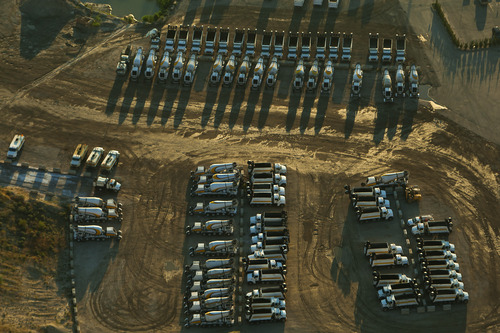


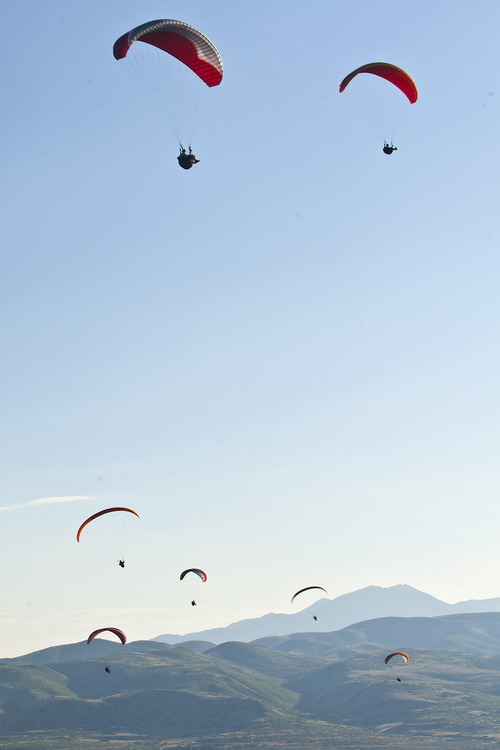
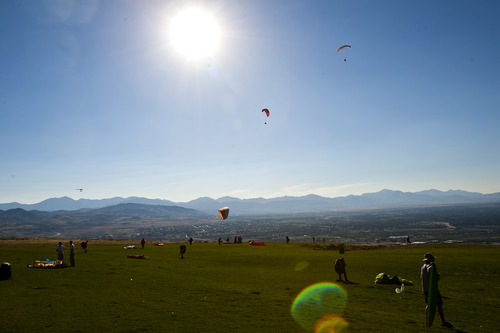
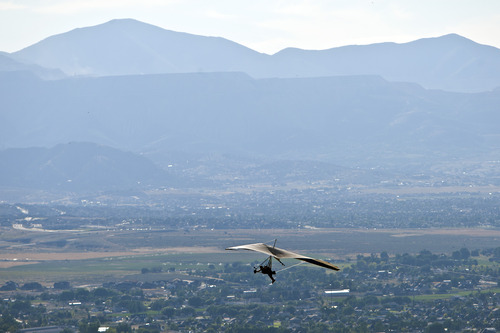
![Chris Detrick | The Salt Lake Tribune
With pollution visible in the background, a paraglider and hang glider fly over Point of the Mountain Flight Park at Steep Mountain near Geneva Rock Products in Draper Friday July 19, 2013. ]](https://archive.sltrib.com/images/2013/0729/dustyair_072813~46.jpg)
